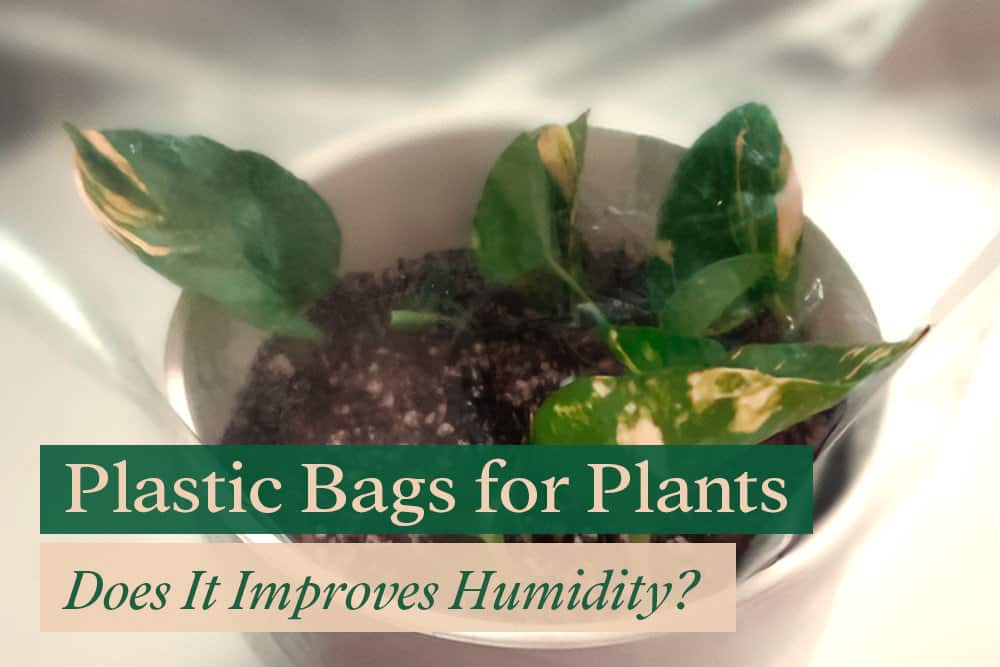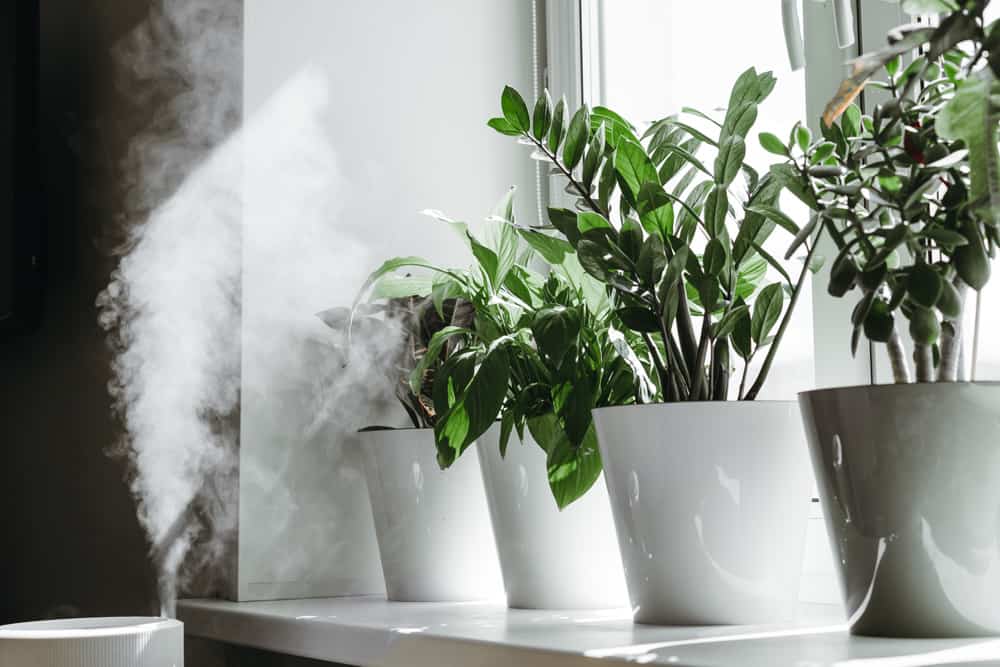
Plastic bags are considered to be an essential tool for today’s indoor gardeners. In addition to serving as growing bags, they can also be used to cover your plants and act as mini greenhouses.
The use of plastic bags to cover indoor plants helps them retain moisture and maintain a high level of humidity. In addition, a plastic bag cover can be used to speed up seed germination or to protect outdoor plants from frost damage.
When using a plastic bag greenhouse, there are a few things you need to keep in mind. When done incorrectly, it can cause more harm to the plants than good.
You’ll learn everything you need to know about using plastic bags as a plant greenhouse in this article.
Let’s get started!
Bloomsprouts may earn an affiliate commission if you purchase something through recommended links.
Why Use Plastic Bags on Plants
You might not like the look of plastic bags covering your plants, but there are several reasons why you might want to do so.
Improving Low-Level Humidity Level
Bagging your plant with a plastic bag is especially useful for tropical plants that require high humidity levels or those that suffer from dry air.
The plastic bag cover traps all moisture released from the plant and soil, creating a tropical environment inside.
The result is an increase in humidity around the plant, which also helps the plant retain moisture better.
It is possible to achieve a 100% humidity level if you do this correctly.
Keep Houseplants Hydrated During Vacation
As most of the moisture released through transpiration and evaporation will be retained inside the bag, your plant will not need to be watered as frequently while you are away.
This is extremely useful if you are going on a long vacation and are not able to water your plants regularly.
The majority of plants can survive for up to two months without watering if you use this technique. It’s not advised to leave the plant any longer than that, since fungal infections may start to develop.
Make sure that you put the bagged plants away from direct sunlight as this could cause the temperature inside the bag to rise, potentially damaging them.
Also Read: How Long Can Plants Go Without Water?
Protect from Extreme Weather
You can also use plastic bags to protect outdoor plants from frost damage.
By covering the plants with a plastic bag, you can create a barrier between the plant and the cold air. This can help to prevent frost damage and keep your plants healthy during the winter months.
However, make sure the leaves do not touch the plastic as this could cause them to become frozen together. Use stakes and hoops to keep the plastic away from the leaves.
Plastic, however, does not have good insulation properties and is not the best winter covering for plants. As an alternative, you can use fabric sheets or frost blankets.
In the morning, when the sun begins to warm up, you should remove the plastic cover so the plant does not overheat.
Speed Up Seeds Germination
Another reason to use plastic bags on plants is to speed up seed germination.
By covering the planting area with a plastic bag, you can create a warm, humid environment that is ideal for germination.
Germination time will vary depending on the plant variety, but most sprout within one or two weeks. When you see the first signs of growth, you can remove the plastic cover.
Consideration When Using Plastic Bags on Plants
Is Too Much Humidity Bad For Plants?
While increasing the humidity around your plant can have many benefits, too much humidity can be just as harmful as not enough.
If the humidity level gets too high, it can create an environment that is conducive to fungal growth on plants and soil. This could lead to root rot or other fungal infections.
Provide Air Circulation
Make sure you monitor the humidity level inside the bag and only cover the plant for a few days at a time to prevent fungal growth.
Remove the plastic as soon as you notice any signs of fungal growth.
You should also poke a few small holes in the bag’s top to allow some air to circulate while still keeping moisture trapped. This will prevent fungal growth.
Place away from direct sunlight
When using plastic bags on plants, it is important to place them in an area where they will not be in direct sunlight.
The sun’s heat can cause the temperature inside the bag to increase, which can damage the plant.
If the light from your window is too bright, you can diffuse it with a sheer curtain or temporarily move the bagged plant to a shadier spot.
How To Use A Plastic Bag Greenhouse
We’ve discussed the pros and cons of using plastic bags for your plants, now let’s take a look at how to properly make a mini greenhouse out of a plastic bag.
Step 1: Remove dead leaves
During prolonged periods of dry air, some leaves may have turned yellow or wilted. For the plant to focus on new growth, it is best to remove these dead leaves.
Step 2: Check for pests and diseases
The high humidity inside the plastic bag will be ideal for many types of pests and diseases. Before you proceed, check the plant for any signs of infestation or infection. You should remove infected leaves and deal with the pests before proceeding.
Step 3: Water the plant and let the excess water drain
When placing the plant inside the plastic bag, you want to make sure that the soil is moist, but not soggy. It is best to water the plant the day before and let the excess water drain before proceeding.
Step 4: Install trellis or sticks
When the plastic touches the leaves for a long time in extremely cold or hot weather, it can damage them.
So, I recommend installing a trellis or sticks to keep the plastic away from the plant’s leaves.
Step 5: Place the plastic
Now, place the plastic bag over the plant. Make sure that the bag is not touching any of the leaves.
You can secure the bag with a twist tie, rubber band, or clothespin.
Step 6: Monitor the plant
When using a plastic bag greenhouse, it is important to monitor the plant closely. You should also check the plant regularly for any signs of fungal growth.
Step 7: Remove the plastic regularly
Every five to seven days, you should remove the plastic bag to allow the plant to breathe and release excess condensation which can contribute to damping off.
Other Ways to Maintain Optimal Humidity for Your Plants
If you are not comfortable using a plastic bag, there are other ways for you to maintain optimal humidity for your plants.
Here are some other options:
Use a Greenhouse
If you have the space, you can set up a small greenhouse in your backyard.
This will provide the perfect environment for your plants and will also allow you to control the temperature and humidity.
Portable Greenhouses
Even if you do not have a lot of space, you can still purchase a portable greenhouse that is big enough to accommodate a few plants.
Since they are small and lightweight, you can move them around your house or take them with you when you move.
I currently use this portable greenhouse. Even though it’s not too big, it can house up to 50 small pot plants!
You can place it outside without any problems. My portable greenhouse has not been damaged by storms or frost, and it has a high humidity level that keeps my plants healthy and safe.
Oh and most importantly, it is very affordable!
Get a humidifier

Another way to maintain optimal humidity for your plants is to get a humidifier. This will help to increase and maintain the humidity in the room where your plants are located.
There are many different types of humidifiers on the market, and you can find one that fits your budget.
Several of them are even smart enough to turn on and off according to the humidity in the room!
Here is my complete guide to choosing the best humidifier for your plants.
Put your plants close together
Plants release moisture through their leaves through a process called transpiration. When you put your plants close together, the released moisture will form a microclimate.
This microclimate will be more humid than the surrounding air, and this will benefit your plants.
Additionally, it’s a good idea to keep plants with similar humidity requirements together.
Place Your Plants in Humid Areas
You can also increase the humidity around your plants by placing them in humid areas of your house such as the bathroom.
The moist air that is released when you take a shower will help to increase the humidity around your plants.
Alternatively, you can let clothes that are wet from the washing machine air dry in the room where your plants are located.
Make a stone tray to put your plant onto
Pebble trays are an easy and effective way to increase the humidity around your plants.
To make one, you will need a shallow dish, some stones, and water.
Simply fill the dish with water and then place the stones on top.
Place your plant pot on top of the stones, and the evaporation from the water will help to increase the humidity around your plant.
Opt for a Two Pot Method
Last but not least, you can also use what is known as the two-pot method.
This is a great way to increase the humidity around your plants without using any electricity.
To do this, you will need two pots that are different sizes. Put your houseplant pot into a pot that is 1-2 inches in diameter larger.
Fill the space between the two pots with sphagnum moss, and then water the moss.
The water will slowly evaporate over the next few days and help to create a humid air around your plant.
As you can see, there are many different ways that you can maintain optimal humidity for your plants.
You can use one or a combination of these methods to create the perfect environment for your plants
Does misting plants help with humidity?
Misting your plants can help to increase the humidity around them, but it is not a long-term solution.
The water will quickly evaporate, and you will need to mist your plants several times a day to maintain the desired level of humidity.
Using a portable greenhouse or installing a humidifier in your home is a better solution.
